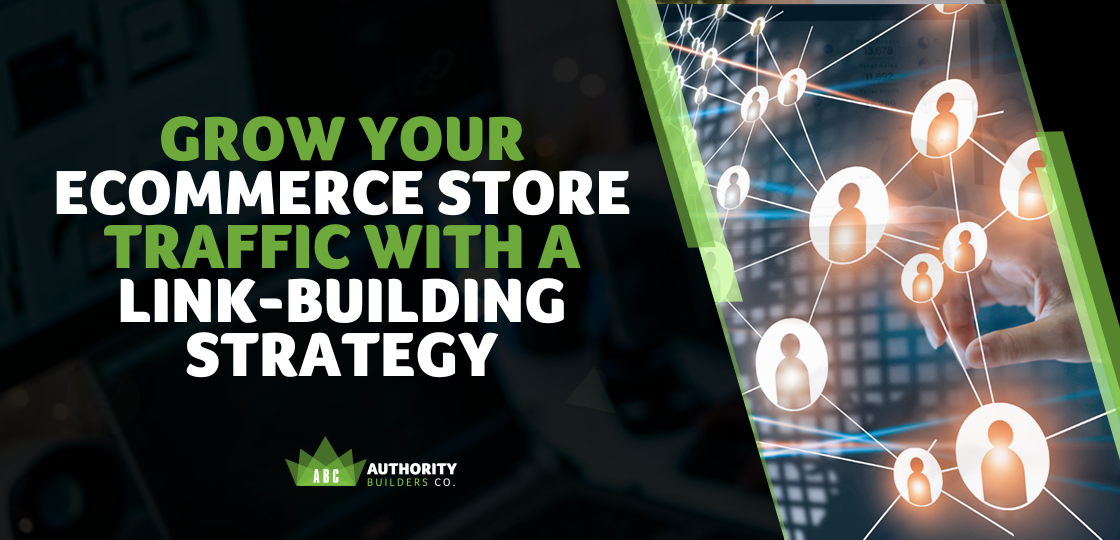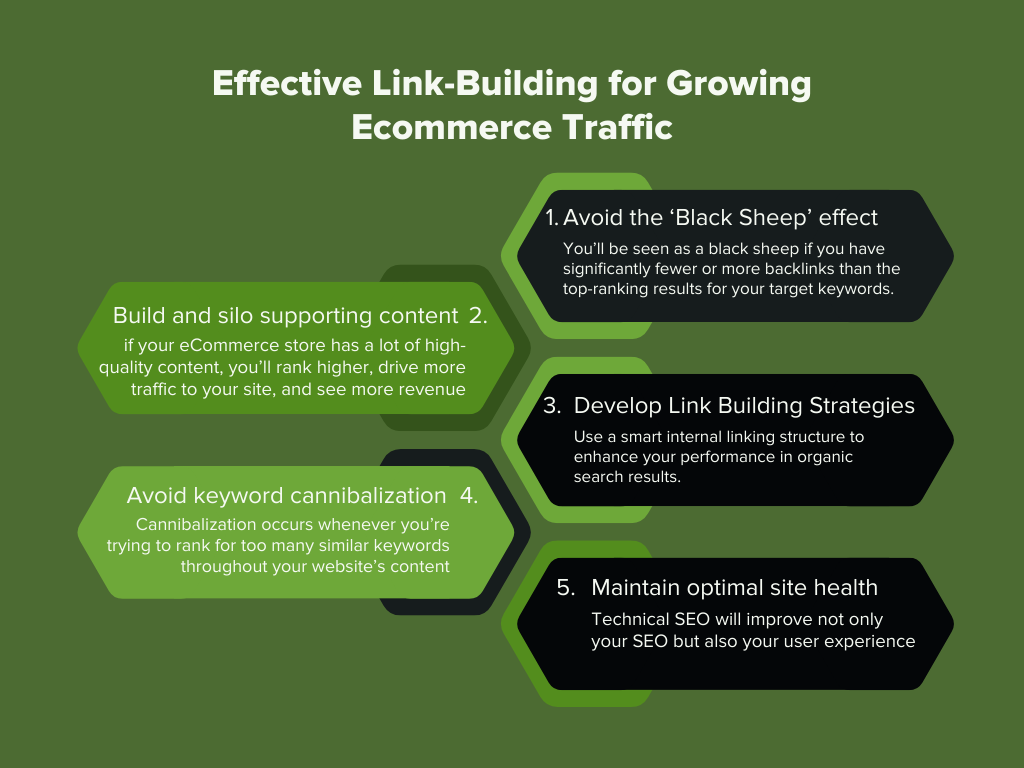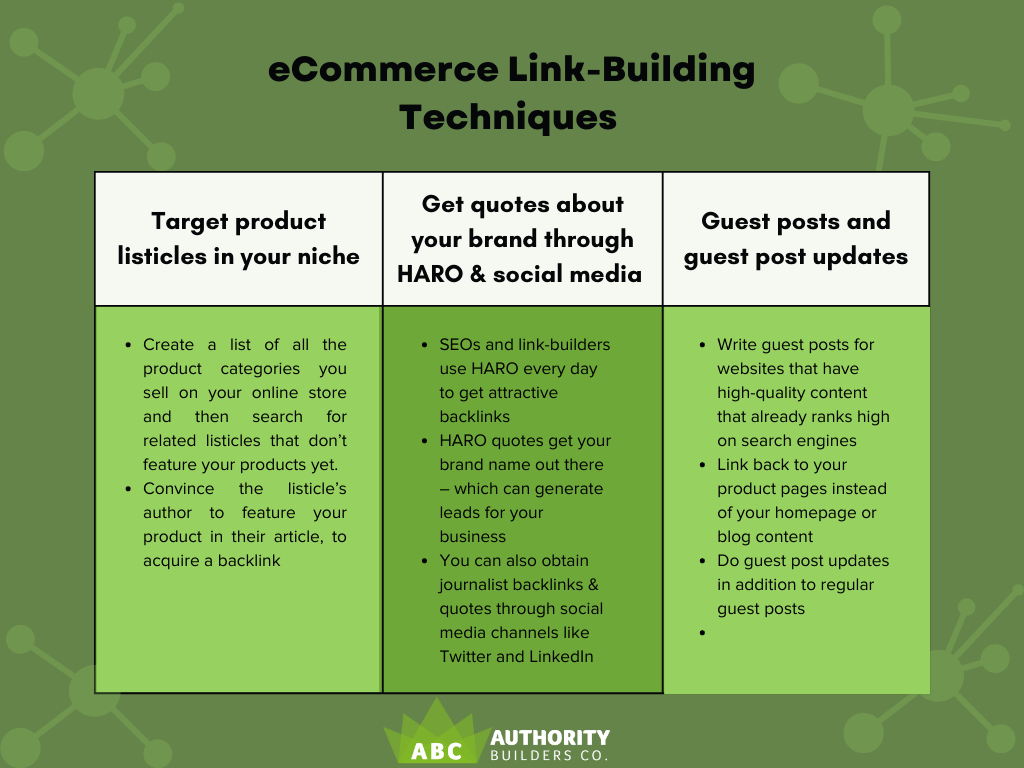
It’s a great time to own an eCommerce store, as industry sales are set to grow by 10.4% in 2023, and 20.8% of all purchases are expected to take place online.
Yet, if you don’t have a link-building strategy in place to drive traffic to your online store, your potential customers will give all their business to your competitors.
So if you want to grow your eCommerce traffic to earn more revenue and grow your business, a link-building campaign is a must.
In fact, a study by Ahrefs discovered that the more high-quality backlinks a page has, the more organic traffic it receives from Google.
Yet, building links for an eCommerce website is a lot different than traditional websites.
That’s because there aren’t too many opportunities to acquire backlinks to product & category pages as there are for blogs, landing pages, videos, and infographics.
That means the links you do build really need to count, so you need to understand what effective link-building looks like – especially in lieu of Google’s recent link spam update and transition to E-E-A-T Quality Rater Guidelines.
We’ve got your back, which is why we put together this extensive guide to increase eCommerce traffic through solid link-building practices.
Stay tuned to discover the most effective ways to build a rock-solid link profile for your eCommerce business.
How Can Link-Building Grow eCommerce Traffic?
Backlinks are the backbone (pun intended) of how Google works, and they played a big part in its inception.
Larry Page and Sergey Brin wanted to come up with a new, more reliable way to rank online content than what was available in the early-to-mid 90s.
Back then, search engines relied solely on keyword placement to rank websites, and no credence was given to the quality or credibility of the content they ranked the highest.
To make a long story short, Google’s founders used backlinks as ‘citations’ or ‘credibility votes’ to gauge the quality & trustworthiness of websites. The idea is similar to citing sources at
Link-building aims to acquire as many of these ‘credibility votes’ as possible through specialized outreach with other websites.
Guest posts, citations, videos, and content marketing are all ways to encourage other high-quality sites to link back to yours, providing an unwritten vow of confidence to search engine algorithms.
Backlinks are among the most important ranking factors in all of SEO for search engines like Google, which means building them will provide a significant rankings boost – especially if you have a stronger link profile than your competitors.
Higher rankings mean you’ll generate more website traffic to your storefront, which will significantly boost your revenue if your product pages are optimized to convert.
What Does Effective Link-Building Look Like?
However, there’s a lot to understand about link-building if you want to see desirable results in Google Search.
In particular, you need to understand the difference between link authority and link relevancy and how they both affect your link profile. Not only that, but you need to know which pages to target backlinks for – such as your homepage, blog, product pages, or pricing pages.
Which pages should you build links for?
It will depend on your goals, but you should include backlinks for every stage of your sales funnel, including both informational and commercial content.
Informational queries are looking for pages like blog posts, statistical infographics, and helpful videos. These queries are from prospects at the top of your sales funnel when they’re looking to educate themselves about your products & services.
Commercial queries tend to include the words ‘compare,’ ‘best,’ or ‘review,’ and they’re looking for your product pages, ‘buy now’ pages, testimonials, and reviews. These types of queries come from potential customers that are ready to make a purchase.
While most SEOs focus on building backlinks to their informational pages, you should not ignore building backlinks to your landing pages & ‘buy now’ pages.
Why is that?
It’s because whenever you link directly to a product page, it’ll receive 100% of the link juice.
If you only link to informational pages, they’ll suck up a majority of the juice, and it’ll keep diluting for every page a customer has to navigate to make a purchase. So for the sake of your conversion rates, don’t shy away from building backlinks directly to your purchase pages.

Avoid the ‘Black Sheep’ effect
Many link-builders make a mistake when they ignore the ‘Black Sheep’ effect.
That’s where you unintentionally make one of your web pages stand out so much that it becomes a black sheep of sorts – and search engines won’t want to touch it.
In particular, you’ll be seen as a black sheep if you have significantly fewer or more backlinks than the top-ranking results for your target keywords.
Remember, the websites ranking in the top results on Google are doing something right, and you want to fall in line with the cool crowd, so to speak. That means conforming to the maximum and minimum number of backlinks that the top-ranking search engine results have.
For instance, if you discover that all the top 10 results have no more than 20 backlinks and no fewer than 15 – you’ll want to hang right in the middle of that sweet spot.
If you build 40 backlinks in an attempt to one-up the competition, your web page will become a black sheep, and you may not even rank in the SERPs at all.
However, if you want the link juice from 40 backlinks powering your web page, there is a way to achieve this.
All you need to do is send those additional backlinks (still stick to the black sheep maximum of 20) to internal pages that link to the web page in question. The link juice will dilute a bit, but it’ll still supercharge your web page without slipping into the ‘black sheep danger zone.’
Build and silo supporting content showing your niche relevance
Link-building for eCommerce sites is made tough due to the lack of backlink opportunities for product pages – but you can create new opportunities through supporting content.
You can create quality content via relevant videos, podcasts, blog content, social media channels, and more.
Popular eCommerce platforms like Shopify allow you to create blog pages, which is great for finding new link opportunities.
This type of content serves two purposes; they provide opportunities to obtain backlinks, and they show off your niche relevance to Google.
Blogs, infographics, videos, and other types of content marketing that are relevant to your target audience will do great things for your search engine optimization strategy. That’s because Google values content that shows experience, expertise, authoritativeness, and trustworthiness.
So if your eCommerce store has a lot of high-quality content, you’ll rank higher, drive more traffic to your site, and see more revenue.
In addition to showing off your niche relevancy, producing stellar supporting content will present new link-building opportunities.
That’s because other websites will want to link to your valuable content on their blogs and on social media platforms.
Video content will also boost your chances of acquiring links, as bloggers love to embed YouTube videos to increase engagement levels with their content. You can use YouTube’s analytics tools to discover who’s embedded your videos, and you can reach out to them to request a backlink to your original page containing the video.
Internal linking strategies
Acquiring backlinks is only one aspect of link-building, as you also need to use a smart internal linking structure to enhance your performance in organic search results.
In particular, you need to use a flat site architecture where each web page is only a few clicks away from the homepage. You also need to ensure that all the pages on your site are interlinked in a way that makes sense. Otherwise, you risk confusing search engine crawlers.
A page is considered ‘orphaned’ whenever you have a web page that has no internal links pointing to it, which is bad news for the page’s crawlability.
Web crawlers use your internal links as a way to make sense of your site architecture, so if you have pages containing no inbound links pointing at them, that page likely won’t get indexed at all.
Logical internal linking strategies improve indexability and strengthen your overall link profile.
Besides ensuring every web page has an internal link, you also need to use keyword-rich anchor text.
That’s because anchor text provides much-needed context to both search engines and your online users. Using relevant keywords in your anchor text will let search engines know more about the page you’re linking to (and the context it plays to the page linking to it).
So when conducting a link-building campaign for your online business, don’t forget to optimize your anchor text and internal linking structure.
Avoid keyword cannibalization
A unique struggle eCommerce sites face when conducting SEO campaigns is trying not to experience keyword cannibalization.
What’s that?
Keyword cannibalization occurs whenever you’re trying to rank for too many similar keywords throughout your website’s content.
This will confuse Google’s algorithm, as it won’t be able to tell which content it should rank higher.
The reason this problem affects eCommerce stores so much is due to the sheer number of pages and products online stores often sell – especially when they have similar names and attributes.
An example would be two product pages selling two different colors of a cowboy hat. The pages would be nearly identical and would have extremely similar keywords and product descriptions. This causes issues with keyword cannibalization and duplicate content, both of which are big no-nos for SEO.
To fix keyword cannibalization issues, you need to decide whether you want to rank your collection page or specific products for a keyword.
In the case of the cowboy hat, you would rank the collection page instead of each color/attribute variation.
You can also avoid duplicate content by using canonical tags.
For instance, marking the standard version of your cowboy hat with a canonical tag will let search engines know to only rank that version of the product and ignore the rest (all marked as non-canon).
Maintain optimal site health
Your technical SEO also has to be in immaculate order if you want to grow eCommerce traffic for your store.
Particularly, that means keeping up with crucial site health factors like site speed, mobile optimization, fixing broken links, and fixing any indexing errors.
These technical tweaks will improve not only your SEO but also your user experience (especially for things like mobile optimization and improving site speed).
eCommerce Link-Building Techniques

Now that you know what effective link-building looks like, it’s time to learn some link-building tactics for eCommerce websites in particular.
Techniques include influencer marketing (primarily for younger demographics), giveaways, HARO, video marketing, and product listicles online.
These tactics will boost brand awareness and help you get the word out about new products, so let’s take a look at the top link-building techniques to grow eCommerce traffic.
Target product listicles in your niche
Odd-numbered listicles are the most popular type of blog post online, and thousands of them count down eCommerce products.
While this may not seem related to link-building at first, you can obtain some highly valuable backlinks by targeting these types of posts.
First, you need to create a list of all the product categories you sell on your online store and then search for related listicles that don’t feature your products yet. If you’re able to convince the listicle’s author to feature your product in their article, you’ll acquire a backlink.
Should you send an email politely asking them to feature your product for a backlink?
No, as Google frowns upon exchanging goods and services for links – and you may incur a manual penalty as a result.
Instead, reach out to them and offer a sample of your product to try.
After all, Google values content that exhibits first-hand experience, especially for product reviews. So if you’re able to provide the listicle’s author with a sample of your product, they’ll be able to give their honest opinions of it in the article – which is what Google wants.
Besides that, you’ll score a valuable backlink, and this is a technique that you can replicate with every relevant product listicle that you can find.
How can you discover product listicles that aren’t featuring your products?
Search for ‘best [product category] –your brand name,’ and dozens of listicles will appear that don’t feature your brand.
That’s a search operator that excludes your brand name, and it comes in handy when hunting down listicles for backlink opportunities.
Get quotes about your brand through HARO & social media
Help a Reporter Out is a website that connects online journalists and reporters with experts, and it’s an excellent source for obtaining backlinks.
This is no secret, as hundreds of SEOs and link-builders use HARO every day in the hopes of snagging attractive backlinks.
While the competition is fierce, it’s still worth throwing your hat in the ring, especially if you’re able to respond within the first five minutes of a request showing up.
Reporters are after valuable quotes, sources, and data from entrepreneurs and experts across all industries, so you’re bound to find requests related to your niche.
Besides the link juice you gain from these backlinks, HARO quotes also get your brand name out there – which can generate leads for your business.
What if you don’t have someone that has the time to monitor HARO updates like a hawk?
You can also obtain journalist backlinks & quotes through social media channels like Twitter and LinkedIn.
Using hashtags like #journoupdate to find backlink opportunities on social media.
You’d be surprised what you can find on platforms like Twitter, as major publications like Huffington Post and Forbes place journalism requests through social media – which are high-value, high-authority backlinks.
Guest posts and guest post updates
Writing guest posts is a coveted link-building practice that’s still effective, but you need to select the right blogs for them.
Ideally, you want to write guest posts for websites that have high-quality content that already ranks high on search engines. That’s because the authority their site carries will bleed over to your website via a backlink (which, remember, is the equivalent of a credibility vote).
To get the most value out of the link juice, try to link back to your product pages instead of your homepage or blog content.
Also, don’t forget about pursuing guest post updates in addition to regular guest posts.
What are those?
A guest post update is where you update an existing blog post for another website. Plenty of content pieces need updating every few months or years, especially when they’re year-specific (i.e., updating an ultimate guide for 2022 to 2023).
The biggest reason you should target guest post updates is you can select posts that already contain desirable backlinks – which means they’ll pass on that link juice to the page you choose to link to.
You can use various SEO tools to uncover outdated blog posts in need of updating, primarily by searching for content that has old years in the title.
Final Thoughts: How to Grow eCommerce Traffic with Link-Building
eCommerce stores face unique challenges with SEO & link–building, but they’re by no means impossible.
In fact, a well-thought-out link-building strategy is the best way to grow eCommerce traffic, especially to your product pages.
Do you need expert help with eCommerce link-building for your online store?
Then don’t wait to check out our incredible link-building packages at Authority Builders. Our digital marketing gurus will take your link profile to new heights, so don’t wait to try out ABC Plus today.
